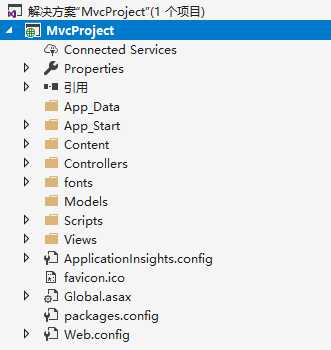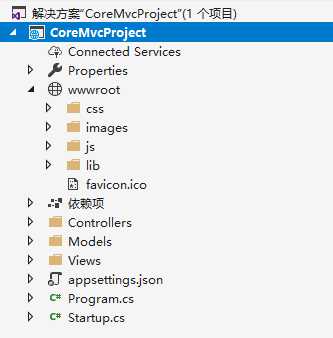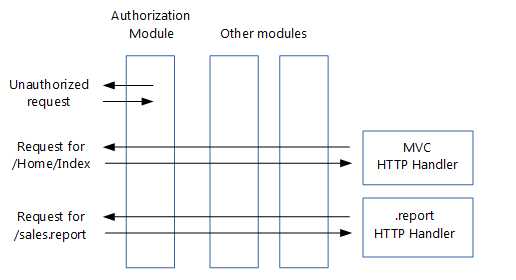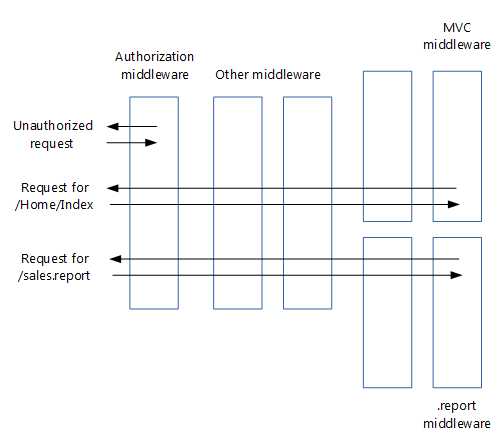标签:授权 pass frame 注册 class font 新建 bsp back
一、前言
这篇文章就是从能看到地方去学习Core,没有很深奥,也没有很难懂,现在我们开始吧。
二、构建项目,引发思考
创建项目的步骤真的很简单,你要是不会,我真也没法了,我这是创建的MVC的项目。


接下来我们开始找不同,这个小学生也会的东西,我相信也难不到大家,这里我们主要说重点的不同:
1. 少了Content和Scripts文件夹,多了wwwroot;
2.少了配置文件web.config,多了appsettings.json;
3.少了App_Start文件夹,多了Program.cs和Startup.cs;
后面确实,实现了前面的功能,接下来引发下我们的思考,带着这些问题我们来学习Core:
配置文件:
1.为什么appsettings.json能默认成为配置文件?
2.怎么读取配置文件?
3.Global.asax如何在core中体现;
DI:
1.为什么全部能按照接口的方式进行注入?
2.怎么替换掉内置的DI?
MVC:
1.Core的请求和MVC的请求有什么不同?
2.Core的认证和授权怎么处理?
怀着这些问题我们来简单结合源码分析下,另外最后我们在上传一个简单的增删改查项目完成我们项目结束。
三、配置文件
GitHub地址:https://github.com/aspnet/MetaPackages/tree/dev/src/Microsoft.AspNetCore
1.为什么appsettings.json能默认成为配置文件?
这个问题看下主要部分在这个地址下面:https://github.com/aspnet/MetaPackages/blob/dev/src/Microsoft.AspNetCore/WebHost.cs,我截取下主要代码;

public static IWebHostBuilder CreateDefaultBuilder(string[] args) { var builder = new WebHostBuilder(); if (string.IsNullOrEmpty(builder.GetSetting(WebHostDefaults.ContentRootKey))) { builder.UseContentRoot(Directory.GetCurrentDirectory()); } if (args != null) { builder.UseConfiguration(new ConfigurationBuilder().AddCommandLine(args).Build()); } builder.UseKestrel((builderContext, options) => { options.Configure(builderContext.Configuration.GetSection("Kestrel")); }) .ConfigureAppConfiguration((hostingContext, config) => { var env = hostingContext.HostingEnvironment; config.AddJsonFile("appsettings.json", optional: true, reloadOnChange: true) .AddJsonFile($"appsettings.{env.EnvironmentName}.json", optional: true, reloadOnChange: true); if (env.IsDevelopment()) { var appAssembly = Assembly.Load(new AssemblyName(env.ApplicationName)); if (appAssembly != null) { config.AddUserSecrets(appAssembly, optional: true); } } config.AddEnvironmentVariables(); if (args != null) { config.AddCommandLine(args); } }) .ConfigureLogging((hostingContext, logging) => { logging.AddConfiguration(hostingContext.Configuration.GetSection("Logging")); logging.AddConsole(); logging.AddDebug(); }) .ConfigureServices((hostingContext, services) => { // Fallback services.PostConfigure<HostFilteringOptions>(options => { if (options.AllowedHosts == null || options.AllowedHosts.Count == 0) { // "AllowedHosts": "localhost;127.0.0.1;[::1]" var hosts = hostingContext.Configuration["AllowedHosts"]?.Split(new[] { ‘;‘ }, StringSplitOptions.RemoveEmptyEntries); // Fall back to "*" to disable. options.AllowedHosts = (hosts?.Length > 0 ? hosts : new[] { "*" }); } }); // Change notification services.AddSingleton<IOptionsChangeTokenSource<HostFilteringOptions>>( new ConfigurationChangeTokenSource<HostFilteringOptions>(hostingContext.Configuration)); services.AddTransient<IStartupFilter, HostFilteringStartupFilter>(); }) .UseIISIntegration() .UseDefaultServiceProvider((context, options) => { options.ValidateScopes = context.HostingEnvironment.IsDevelopment(); }); return builder; }
2.怎么读取配置文件?
我主要提供了2种方式,这里前提是引入Microsoft.AspNetCore.All这个dll,这个里面很多我们需要的东西
从appsettings.json增加配置读取,有两种一个是更改配置以后立即生效,一种是重启以后才生效,具体看下代码:

//配置如下 "JwtSettings": { "Issuer": "http://localhost:52588", "Audience": "http://localhost:52588", "SecretKey": "1235455llllll" }, "UserSetting": { "Name": "wtzzzzz", "Age": 12 } //读取配置 public void ConfigureServices(IServiceCollection services) { services.Configure<CookiePolicyOptions>(options => { // This lambda determines whether user consent for non-essential cookies is needed for a given request. options.CheckConsentNeeded = context => true; options.MinimumSameSitePolicy = SameSiteMode.None; }); services.AddMvc().SetCompatibilityVersion(CompatibilityVersion.Version_2_1); //读取JWT配置文件 services.Configure<JwtSettingsModel>(Configuration.GetSection("JwtSettings")); //读取User配置文件 services.Configure<UserSettingModel>(Configuration.GetSection("UserSetting")); } //controller读取 //不支持实时更新 private readonly IOptions<JwtSettingsModel> _jwtConfiguration; //支持实时更新 private readonly IOptionsSnapshot<UserSettingModel> _userConfiguration; public HomeController(IOptions<JwtSettingsModel> jwtConfiguration,IOptionsSnapshot<UserSettingModel> userConfiguration) { _jwtConfiguration = jwtConfiguration; _userConfiguration = userConfiguration; } public IActionResult Index() { ViewBag.Issuer = _jwtConfiguration.Value.Issuer; ViewBag.Name = _userConfiguration.Value.Name; ViewBag.PersonName =AppConfigurtaionHelper.GetAppSettings<PersonAppSettingModel>("PersonSetting").Area; return View(); }
从外部引入配置文件,这个时候我们要做一件事情,将你新建的配置文件的属性设置为始终复制,至于这个原理是啥我不懂,有大神可以指点下,剩下的具体看代码吧;

{ "PersonSetting": { "Area": "China" } } //外部的工具类 public class AppConfigurtaionHelper { public static T GetAppSettings<T>(string key) where T : class, new() { IConfiguration config = new ConfigurationBuilder() .Add(new JsonConfigurationSource { Path = "/Config/setting.json", ReloadOnChange = true }) .Build(); var appconfig = new ServiceCollection() .AddOptions() .Configure<T>(config.GetSection(key)) .BuildServiceProvider() .GetService<IOptions<T>>() .Value; return appconfig; } }
3.Global.asax如何在core中体现;

public void Configure(IApplicationBuilder app, IHostingEnvironment env,IApplicationLifetime application) { if (env.IsDevelopment()) { app.UseDeveloperExceptionPage(); } else { app.UseExceptionHandler("/Home/Error"); app.UseHsts(); } //类似于Application //开始 application.ApplicationStarted.Register(() => { Console.WriteLine("开始了注意"); }); //运行中 application.ApplicationStopping.Register(() => { Console.WriteLine("运行中"); }); //结束 application.ApplicationStopped.Register(() => { Console.WriteLine("结束了休息下"); }); app.UseHttpsRedirection(); app.UseStaticFiles(); app.UseCookiePolicy(); app.UseMvc(routes => { routes.MapRoute( name: "default", template: "{controller=Home}/{action=Index}/{id?}"); }); }
IApplicationLifetime这个实现替代在传统应用中Application中生命周期的位置,这个我在上面的代码中已有体现,使用命令的方式运行在控制台就可以看到;
四、DI
针对这个问题,我只能这么说为了为了提高大家,给大家实现一个容器,让大家玩的开心一下,让DI和IOC的思想深入内心,这点有点类似Java操作了,其实早就该这样了,已经让我们变大太懒了,哈哈,借用下蒋神的话,ASP.NET Core的核心是通过一个Server和若干注册的Middleware构成的管道,不论是管道自身的构建,还是Server和Middleware自身的实现,以及构建在这个管道的应用,都需要相应的服务提供支持,ASP.NET Core自身提供了一个DI容器来实现针对服务的注册和消费。换句话说,不只是ASP.NET Core底层框架使用的服务是由这个DI容器来注册和提供,应用级别的服务的注册和提供也需要以来这个DI容器,所以正如本文标题所说的——学习ASP.NET Core,你必须了解无处不在的“依赖注入”。
附上大神的地址:https://www.cnblogs.com/artech/p/dependency-injection-in-asp-net-core.html
不懂DI和IOC的我也附上腾飞大神的地址:https://www.cnblogs.com/jesse2013/p/di-in-aspnetcore.html,
腾飞大神博客里面已经将我想要的说2个问题说的很明白了,我这里还是在稍稍说一下吧。
生命周期问题:
Transient: 每一次GetService都会创建一个新的实例
Scoped:每次Http请求只会产生一个实例;
Singleton:整个应用程序生命周期以内只创建一个实例
这个大神博客里面也有介绍,官方也有介绍,大家可以看下https://docs.microsoft.com/zh-cn/aspnet/core/fundamentals/dependency-injection?view=aspnetcore-2.1
容器的替换:

public IServiceProvider ConfigureServices( IServiceCollection services){ services.AddMvc(); // Add other framework services // Add Autofac var containerBuilder = new ContainerBuilder(); containerBuilder.RegisterModule<DefaultModule>(); containerBuilder.Populate(services); var container = containerBuilder.Build(); return new AutofacServiceProvider(container); }
五、MVC
1.Core的请求和MVC的请求有什么不同?
看图说话,主要设计不同主要体现在蒋神说的那句话,Core按照中间件的形式设计,最后全部注入到DI,这个时候我们考虑一个问题,我们想替换任何一个都将变得很容易,但是同样我们又会衍生另外一个问题,当我们服务之间存在依赖的时候,就需要按照顺序进行注入,这个问题需要重视一下,当然微软在设计上也考虑到这点,这里也是简单写个小demo,当你访问网站的时候就会发现网站按照顺序输出来了。MVC还是在IHttpMoudle和IHttpHandle上面做扩展或解耦,整体上本质是不变得,对这块不了解的可以推荐几篇博客给大家看看;推荐大龙龙MVC系列:http://www.cnblogs.com/edisonchou/p/3911558.html



//注册中间件 app.Use(async (context,next)=> { await context.Response.WriteAsync("1"); await next.Invoke(); }); app.Use(next => { return (context) => { context.Response.WriteAsync("2"); return next(context); }; }); app.Run(async (context) => { await context.Response.WriteAsync("3"); });
六、结束
下一篇我们再说,Demo还没时间做好,另外强烈推荐大家去看官方文档:https://docs.microsoft.com/zh-cn/aspnet/core/migration/http-modules?view=aspnetcore-2.1,真的比什么都管用!!!
标签:授权 pass frame 注册 class font 新建 bsp back
原文地址:https://www.cnblogs.com/wtzbk/p/9196185.html